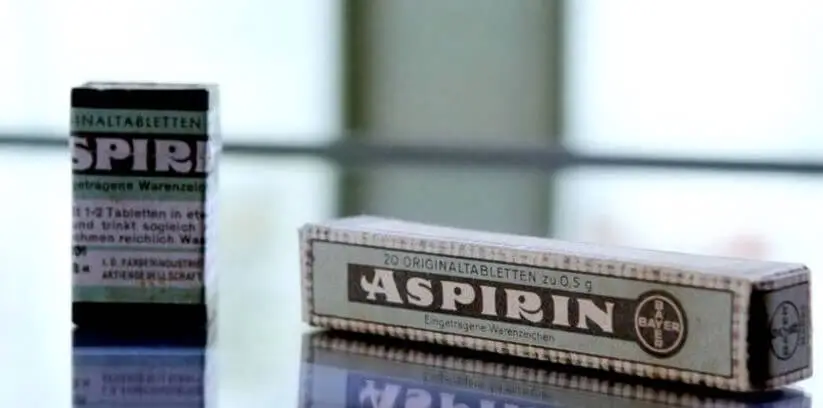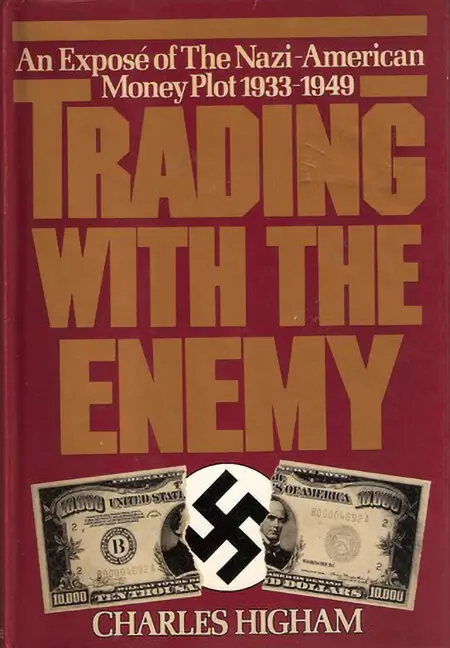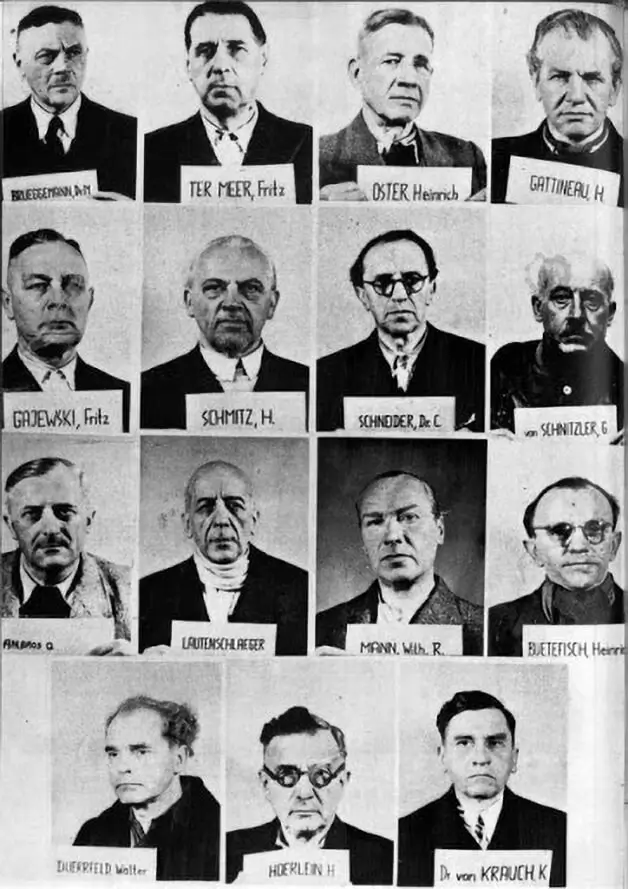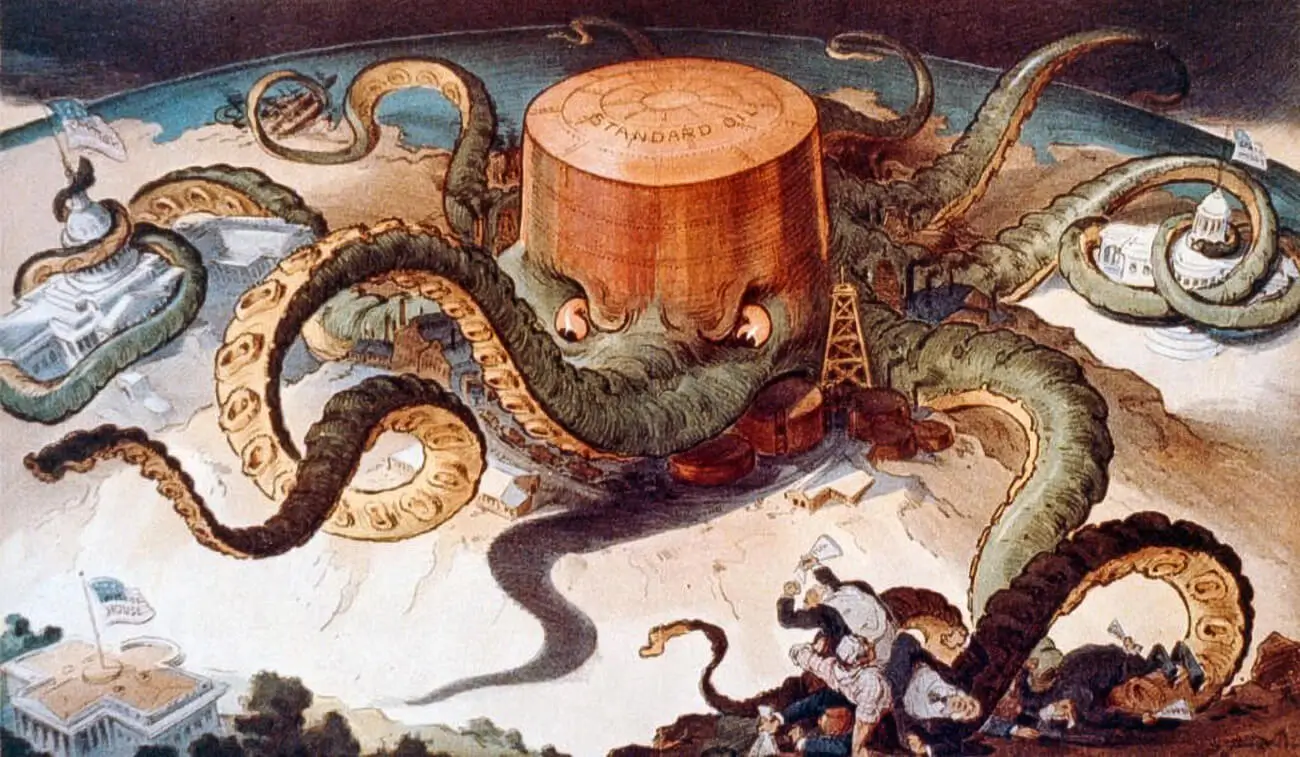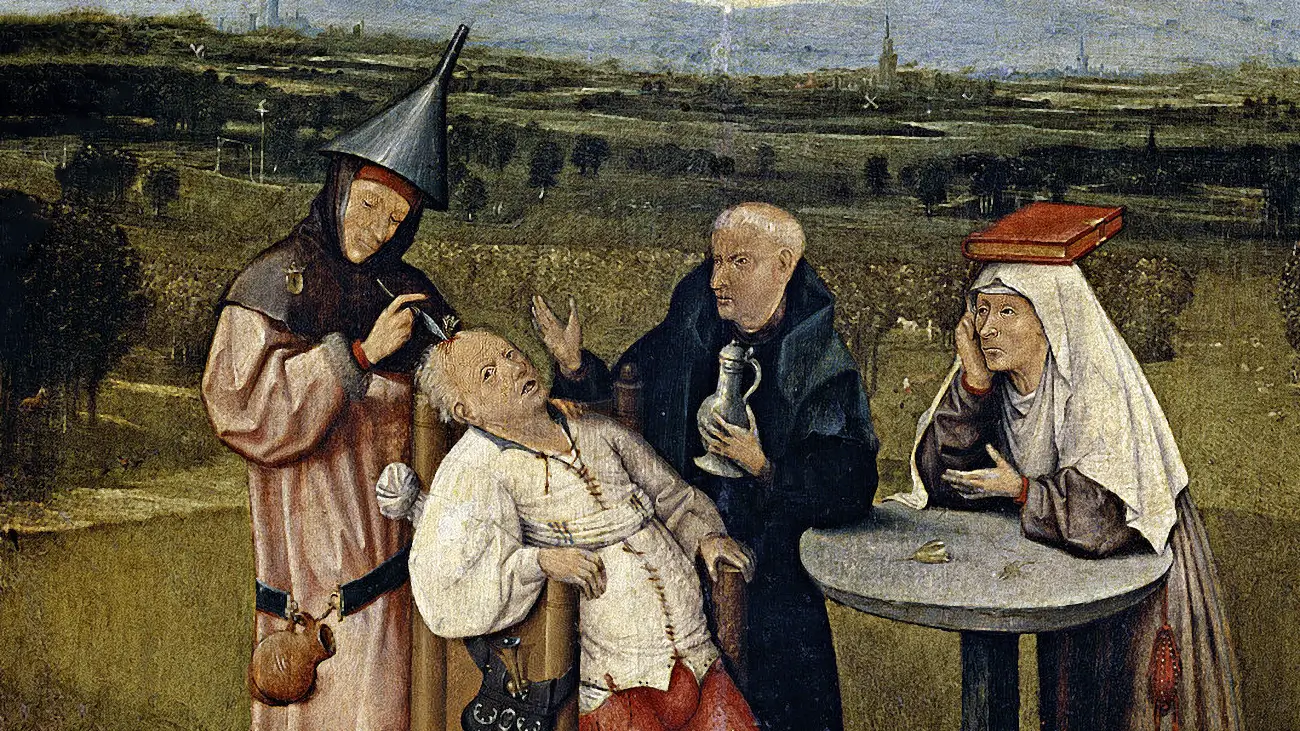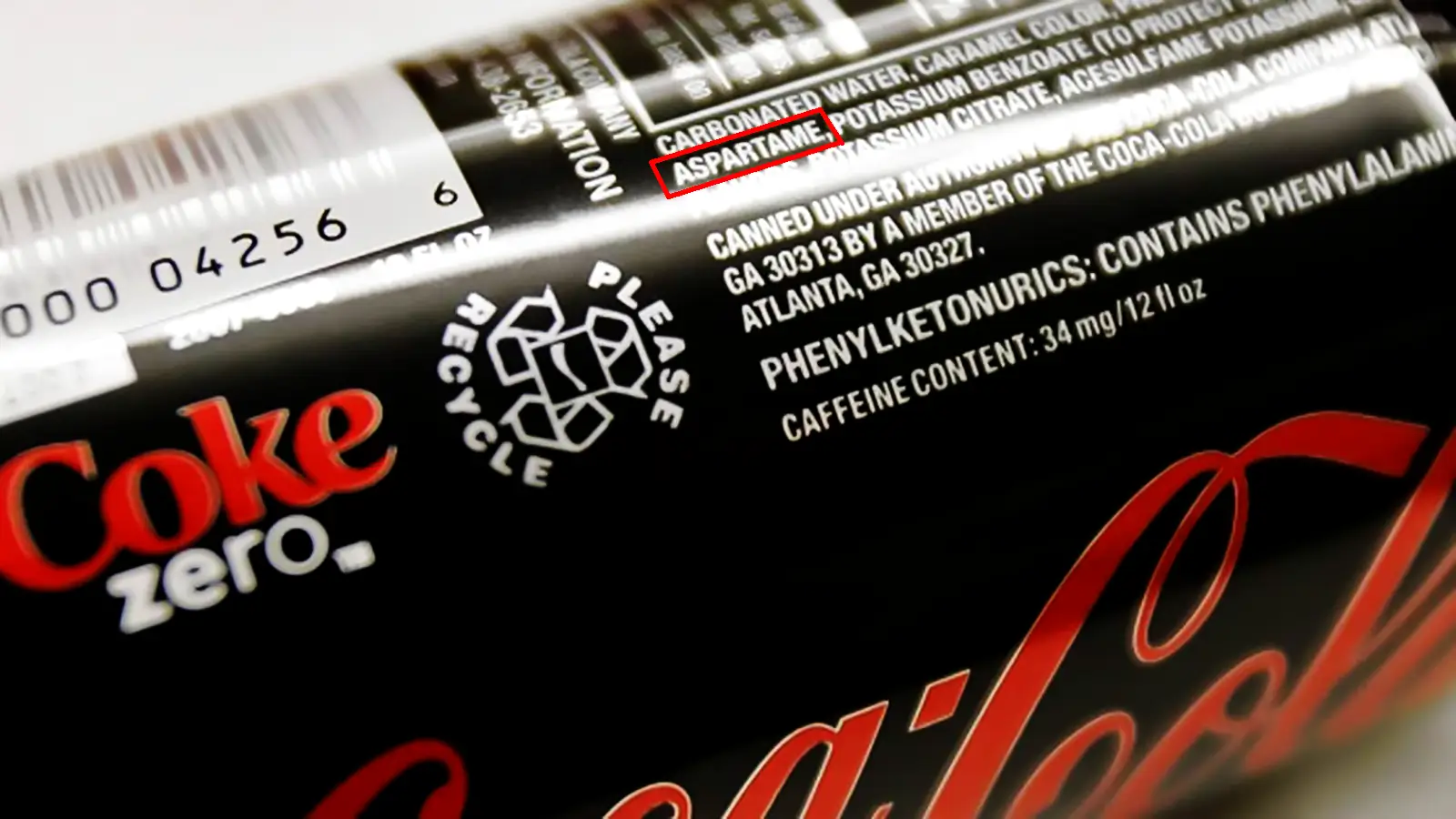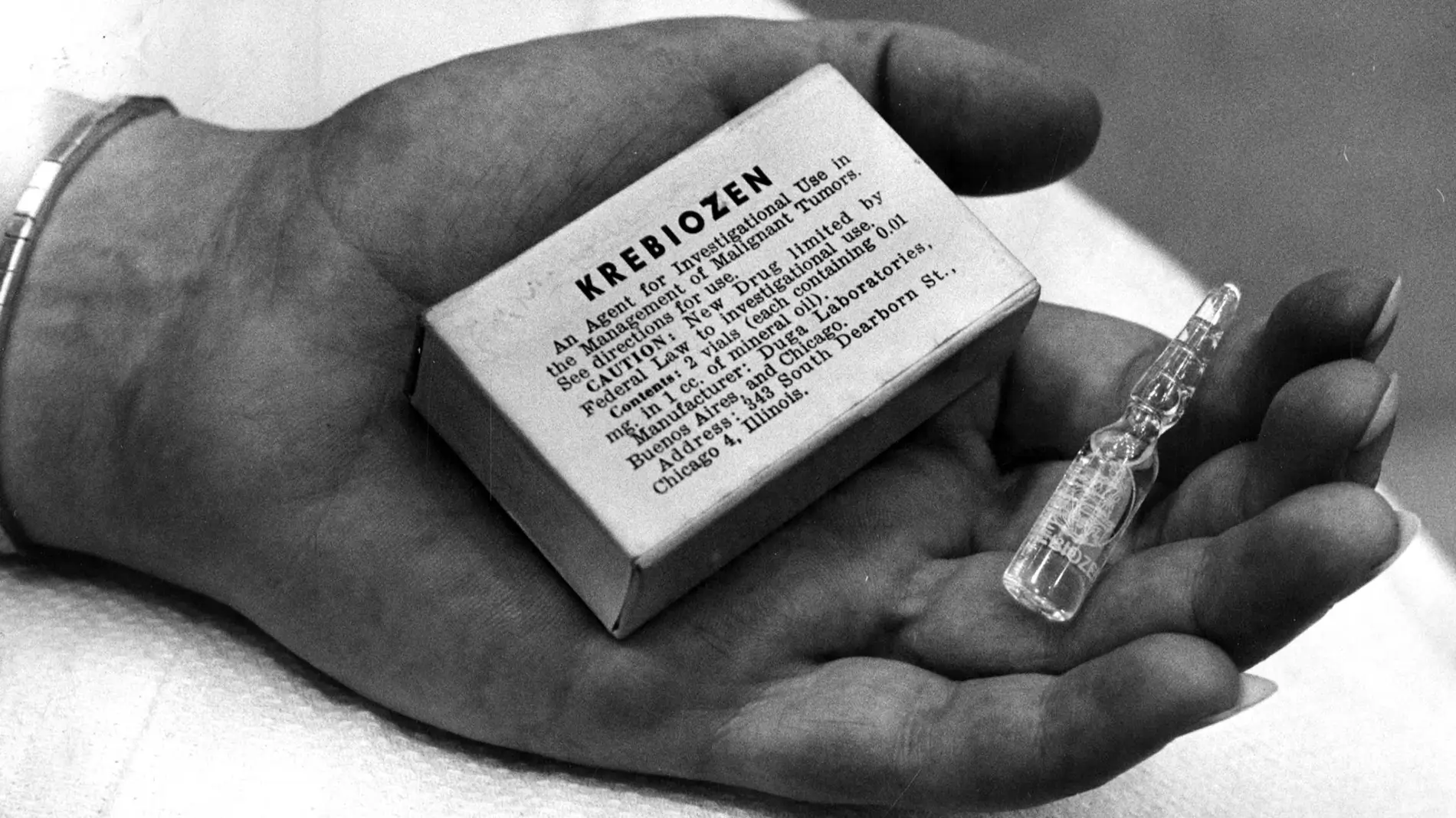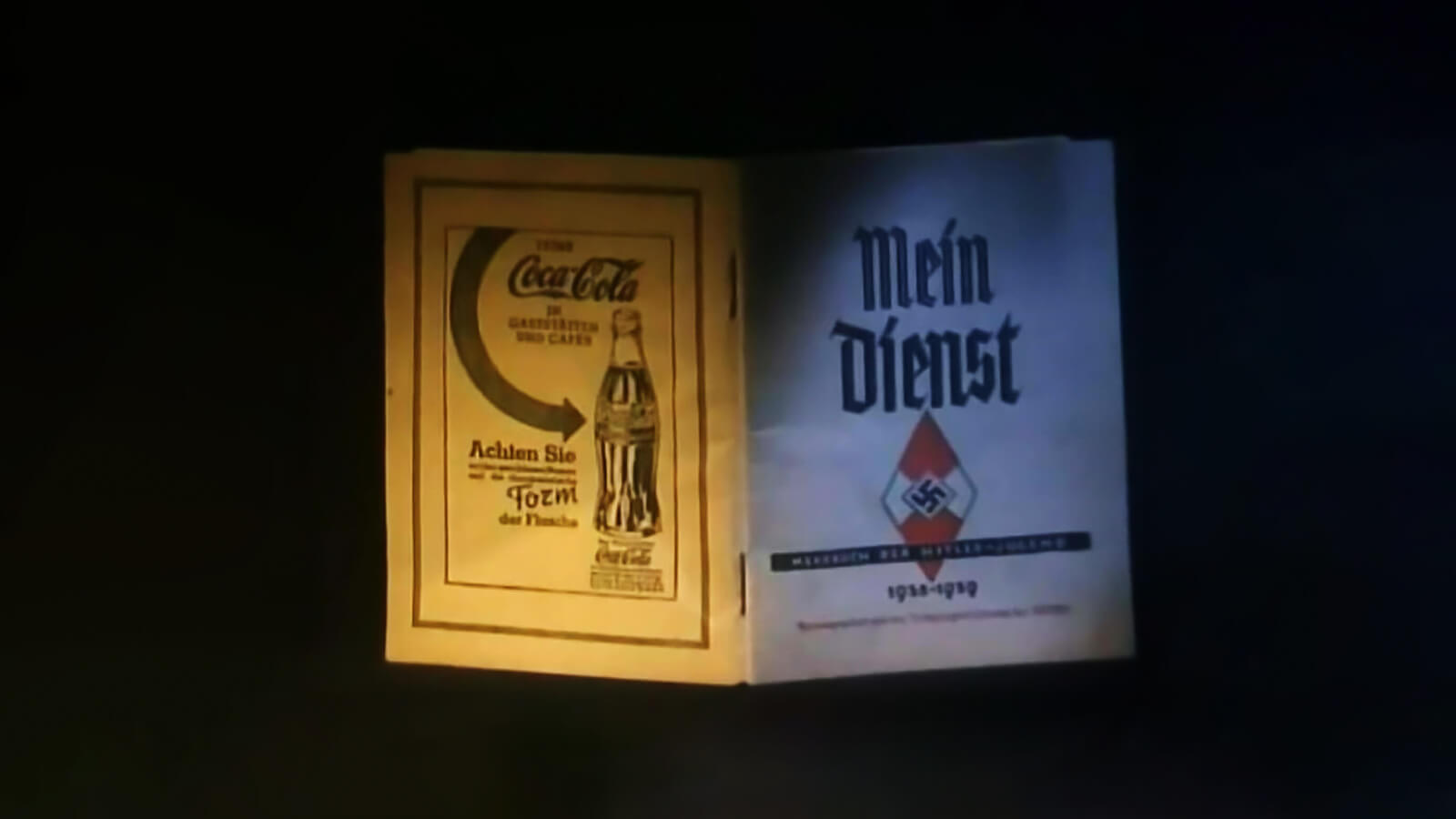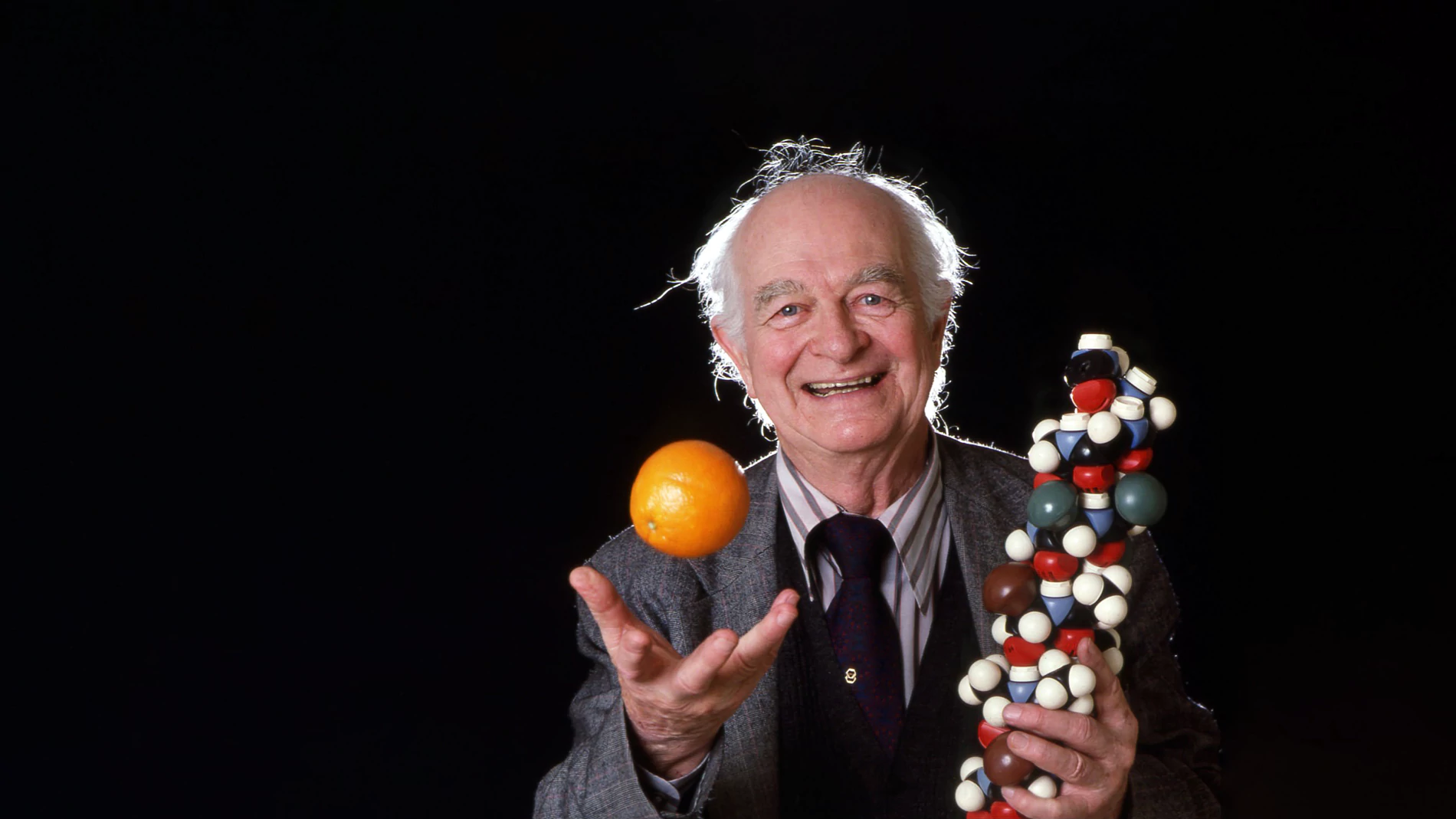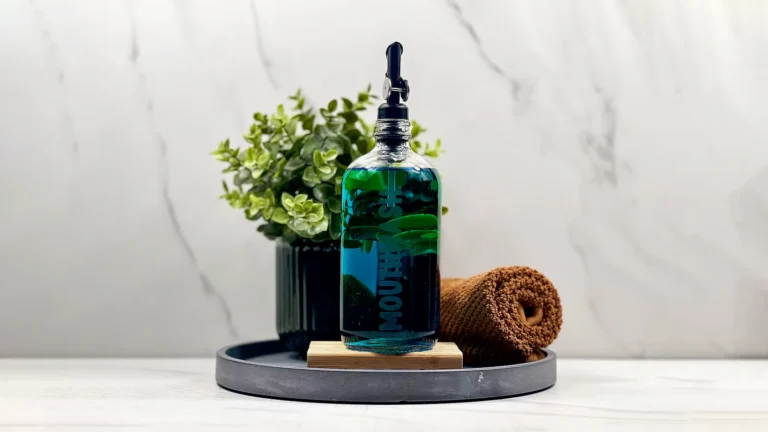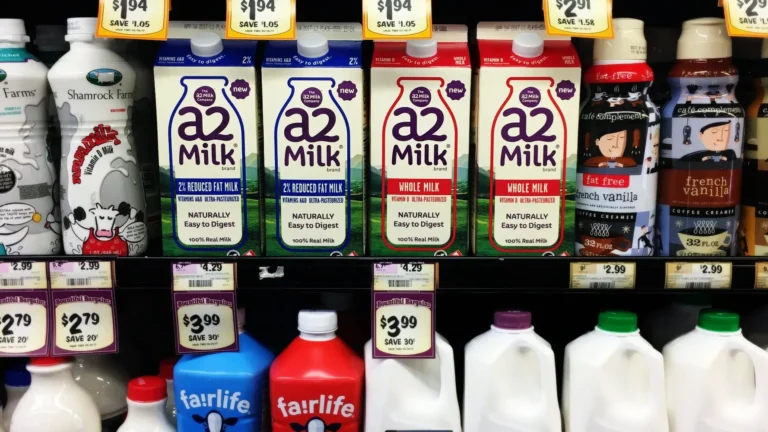Die Geschichte von Big Pharma- IG Farben
Der Teil des Rockefeller-Monopols auf die Chemie- und Medizinindustrie wurde nach dem Zweiten Weltkrieg erfüllt. Durch die Zusammenarbeit von Standard Oil und IG Farben wurde dies Wirklichkeit.
Milos Pokimica
Geschrieben von: Milos Pokimica
Medizinisch Begutachtet Von: Dr. Xiùying Wáng, M.D.
Aktualisiert am 7. Mai 2023„Die Freiheit einer Demokratie ist nicht sicher, wenn die Menschen das Anwachsen privater Macht bis zu einem Punkt tolerieren, an dem sie stärker wird als ihr demokratischer Staat selbst.“ Das ist im Wesentlichen der Faschismus – das Eigentum an der Regierung durch ein Individuum, eine Gruppe oder eine kontrollierende Privatmacht.“
-Präsident Franklin D. Roosevelt
Der Teil des Rockefeller-Monopols auf die chemische und medizinische Industrie wurde nach dem Zweiten Weltkrieg verwirklicht. Und zwar auf globaler Ebene, nicht nur in den USA. Die Zusammenarbeit von Rockefeller und Rothschild machte dies zur Realität.
Auf der anderen Seite des Atlantiks wurde 1925 das internationale Drogen- und Chemiekartell IG Farben, der "Staat im Staat", als Interessen Gemeinschaft Farbenindustrie Aktien Gesellschaft gegründet, gewöhnlich bekannt als IG Farben, was einfach "Das Kartell" bedeutete. Die IG Farben hatte bis zum Zweiten Weltkrieg ein absolutes Monopol auf die Herstellung aller chemischen Produkte. Sie waren einer, wenn nicht sogar der entscheidende Finanzier der Wiederaufrüstung Deutschlands mit einem besonderen Interesse an der Ölproduktion für Deutschlands neue mechanisierte Armee.
Es begann im Jahr 1904, als die sechs größten Chemieunternehmen in Deutschland Vereinbarungen zur Bildung eines endgültigen Kartells trafen und Badische Anilin, Bayer, Agfa, Hoechst, Weiler-ter-Meer und Griesheim-Electron fusionierten. Die Hauptfinanzierung kam von den Rothschilds, die weiterhin von ihrem deutschen Bankier Max Warburg von der MM Warburg Company, Hamburg, vertreten wurden. Später leitete er den deutschen Geheimdienst während des Ersten Weltkriegs und war ein privater Wirtschaftsberater des Kaisers. In der Zwischenzeit wurde der Kaiser gestürzt, nachdem er den Krieg verloren hatte, aber Max Warburg wurde nicht mit ihm ins Exil geschickt, da er als Vertreter einer höheren Macht über der Politik stand und daher nie nach Holland ging. Stattdessen wurde er zum wirtschaftlichen Berater der neuen Regierung. Außerdem vertrat er Deutschland auf der Pariser Friedenskonferenz. Max Warburg verbrachte erholsame Zeiten damit, die familiären Beziehungen zu seinem Bruder Paul Warburg wiederherzustellen, der nach der Einberufung des Federal Reserve Act auf Jekyll Island während des Krieges das US-Bankensystem kontrollierte. Er war auch in Paris als Finanzberater von Woodrow Wilson anwesend.
Zwei Brüder kontrollierten zwei verschiedene Bankensysteme in Ländern, die sich angeblich im Krieg miteinander befanden. Vor dem Zweiten Weltkrieg gehörte Max Warburg dem Vorstand der IG Farben an. Sein Bruder Paul Warburg gehörte dem Verwaltungsrat der IG Farben an, die sich im Besitz einer amerikanischen Tochtergesellschaft befand. Die Familie Warburg war eine prominente deutsche und amerikanische Bankiersfamilie deutsch-jüdischer und ursprünglich venezianisch-jüdischer Abstammung, die den Nachnamen del-Banco trug. Allerdings stand die Warburg-Bank in Hamburg 1857 kurz vor dem Zusammenbruch, woraufhin die Rothschilds riesige Geldsummen in die Bank steckten und deren neuer Eigentümer wurden. Von dieser Zeit an agierten die M.M. Warburg Bank und ihre Partner effektiv als Rothschild-Fronten. Das erste Mitglied, von dem bekannt ist, dass es den Namen "Rothschild" verwendete, war Izaak Elchanan Rothschild, geboren im Jahr 1577. Der Name Rothschild bedeutet auf Jiddisch "Roter Mantel". Die I.G. Farben wurde schnell zu einem Unternehmen, das ein Nettovermögen von sechs Milliarden Mark hatte und mehr als fünfhundert Firmen kontrollierte.
Während die Weimarer Republik zu kollabieren begann, begannen IG-Funktionäre, die die Zeichen der Zeit erkannten, eine enge Zusammenarbeit mit Adolf Hitler, indem sie enorme Mengen an benötigten Mitteln und politischem Einfluss bereitstellten. Die Fortschritte des I.G.-Farben-Kartells hatten das Interesse anderer Industrieller geweckt und sich auch auf sie übertragen. Henry Ford war ziemlich beeindruckt und gründete eine deutsche Niederlassung der Ford Motor Company. Die IG Farben erwarb vierzig Prozent der Aktien. Als Nächstes baute die I.G. Farben in Zusammenarbeit mit Standard Oil of New Jersey eine amerikanische Tochtergesellschaft, die American I.G., auf. 1930 erklärte Standard Oil, dass es in Deutschland ein Schnapsmonopol erworben hatte, das es mit der IG Farben vereinbart hatte. Das Unternehmen war bereits dabei, sich in Europa auszubreiten. Nahrungsmittelindustrie. Nachdem die Nazipartei an die Macht gekommen war, heuerte John D. Rockefeller seinen eigenen Presseagenten, Ivy Lee, bei Hitler an, um als Vollzeitberater für die Wiederbewaffnung Deutschlands zu arbeiten. Sie hatten bereits beschlossen, Deutschland aufzurüsten und den Zweiten Weltkrieg auszurufen, so dass schon damals die notwendigen Schritte zur Vorbereitung des Zweiten Weltkriegs eingeleitet worden waren. Standard Oil baute daraufhin große Raffinerien in Deutschland für die Nazis und belieferte sie auch während des Zweiten Weltkriegs mit Öl. Im Jahr 1939 besuchte Frank Howard, ein Vizepräsident von Standard Oil, Deutschland und traf einige Vorkehrungen. Er sagte später aus:
"Wir haben unser Bestes getan, um vollständige Pläne für einen Modus Vivendi auszuarbeiten, der während der gesamten Dauer des Krieges funktionieren würde, unabhängig davon, ob wir kommen oder nicht. "
Obwohl sein Name kaum bekannt ist, war Frank Atherton Howard zu jener Zeit einer der wichtigsten Agenten, die die Geschäfte von Standard Oil leiteten. In den 1930er Jahren war er außerdem Leiter des Forschungsausschusses am Sloan Kettering Institute. Er war ein Agent der Rockefellers und war gut in seinem Job. Sein Beauftragter bei Sloan Kettering, Dusty Rhoads, leitete die Forschung zur Entwicklung der Chemotherapie. Während des Zweiten Weltkriegs leitete Rhoads den Chemical Warfare Service in Washington im Hauptquartier der US-Armee. Dieselben Männer forschten an einem Heilmittel für Krebs und an Chemikalien für die Tötung von Menschen in Kriegen, was inzwischen vertraut klingt. Männer, die für das Rockefeller-Syndikat arbeiten. Es war Frank Howard, der sowohl Alfred Sloan als auch Charles Kettering von General Motors 1939 dazu bewegte, große Spenden an das Krebszentrum zu geben, das dann ihre Namen annahm. Frank Howards zweite Frau war ein führendes Mitglied der britischen Aristokratie, die Herzogin von Leeds. Ich schreibe seinen Familienstand nur auf, damit wir verstehen können, was Regierung, Aristokratie, Demokratie, Kapitalismus usw. in Wirklichkeit sind. Es ist alles dasselbe. Frank Howard war die wichtigste Führungskraft in der Verwaltung der Beziehungen zwischen Standard Oil und IG Farben und arbeitete daran, die Interessen beider Unternehmen zu koordinieren. Er leitete die Forschung zur Weiterentwicklung von künstlichem Kautschuk, der für Deutschland im Zweiten Weltkrieg lebenswichtig war. Später schrieb er sogar ein Buch, "Buna Rubber". Und die IG Farben war auch ein direkter Unterstützer der Nazi-Partei ohne jegliche Geheimhaltung.
Auf einer Konferenz deutscher Industrieller mit Nationalsozialisten wie Hermann Göring und Heinrich Himmler, die am 20. Februar 1933 stattfand, spendete die IGF 400.000 Reichsmark an die NSDAP. Dies war der größte Einzelbetrag der Gesamtsumme von 3 Millionen Reichsmark, die die deutschen Industriellen auf diesem Treffen für den Wahlkampf der NSDAP gesammelt hatten. Die IG Farben hatte 1933 viereinhalb Millionen Reichsmark an die NSDAP gespendet; bis 1945 hatte die I.G. der Partei 40 Millionen Reichsmark zur Verfügung gestellt, eine Summe, die alle Spenden der I.G. an alle anderen Begünstigten in diesem Zeitraum übertraf. Lassen Sie mich nun folgende Frage stellen. Glauben Sie, dass die amerikanischen oder englischen Regierungen nicht wussten, was vor sich geht und woher das Geld kommt? Sie planten und finanzierten den gesamten Zweiten Weltkrieg absichtlich. Ohne die klare Hilfe von Standard Oil wäre die Nazi-Luftwaffe beispielsweise überhaupt nicht in der Lage zu fliegen. Die Flugzeuge der Luftwaffe benötigten Tetraethylblei-Benzin, um fliegen zu können. Damals waren nur General Motors, Standard Oil und Du Pont in der Lage, diesen lebenswichtigen Stoff herzustellen. Alle Unternehmen außerhalb Deutschlands. Im Jahr 1938 beauftragte Walter C. Teagle, der Direktor von Standard Oil, Hermann Schmitz von der IG Farben, 500 Tonnen Tetraethylblei von Ethyl, einer Tochtergesellschaft von British Standard Oil, zu beziehen. Ein Jahr später kehrte Schmitz nach London zurück und kaufte zusätzlich Tetraethylblei im Wert von 15 Millionen Dollar. Dann wurde es in Deutschland zu Flugbenzin für die Luftwaffe verarbeitet.
1927 gründeten Standard Oil und IG Farben das Unternehmen "Standard IG Farben". Standard überließ der IG Farben die Patente für die Kohlehydrierung, und die Deutschen gaben ihnen die Patente für die Herstellung von synthetischem Kautschuk. Während die europäischen Mächte das Wachstum der deutschen Industrie nach dem Ersten Weltkrieg verhindern wollten, gaben die USA riesige Geldsummen für den Wiederaufbau Deutschlands aus und ratifizierten den Versailler Vertrag nie. Eigentlich nicht die Regierung der USA, sondern die wirkliche Macht des tiefen Staates dahinter. Sie verkauften sogar deutsche Anleihen auf dem US-Finanzmarkt. Eine der wichtigsten war die "Union Banking Corporation" von George H. Walker. Er ernannte seinen Schwiegersohn Prescott Bush, den Großvater von US-Präsident George W. Bush, zum Direktor der Firma.
Sein Enkel, der damalige amerikanische Präsident George W. Bush, war im Update 3.0, hielt Händchen mit dem israelischen Premierminister und sprach über die Einheit des amerikanischen und israelischen Volkes im „Krieg des Terrors“, wobei er die Tatsache vergaß, dass sein Großvater Prescott Jüdisch benutzte Sklavenarbeit in seiner Stahlarbeiterfabrik in Auschwitz.

In Update 1.0 lieferte Prescotts Vater Samuel P. Bush, langjähriger Präsident des Unternehmens Buckeye Steel Castings, das Frank Rockefeller, dem Bruder von John D. Rockefeller, gehörte, Teile für die Edward Henry Harriman-Eisenbahn, die wiederum Johns Standard Oil mit Bahntransporten versorgte, das wiederum von den Rothschilds eine Monopolfinanzierung erhielt. Samuels Sohn Prescott war Geschäftsführer einer Nazi-Stahlfabrik in Polen namens Celestion Consolidated Steel, der in Update 2.0 amerikanische Finanzmittel an seinen deutschen Partner Fritz Thyssen über die "Union Banking Corporation" in New York weiterleitete. Fritz Thyssen schloss mit der IG Farben einen Vertrag über kostenlose jüdische Sklavenarbeit in der Bush-Stahlfabrik im Konzentrationslager Auschwitz ab.
In Update 2 werden Prescott Busch und Averell Harriman (Sohn des Eisenbahnbarons E. H. Harriman, 48. Gouverneur von New York und Kernmitglied der Gruppe der außenpolitischen Weisen, die als "The Wise Men" bekannt sind, sowie Mitglied von Skull and Bones) beim Handel mit dem Feind erwischt, als die US-Regierung eingreift und alle Aktien der Union Banking Corporation beschlagnahmt.
In Update 4.0 ist Prescotts Sohn, der erste George Bush, Direktor der CIA. George drängt den Drogenkönig Manuel Noriega auf die Gehaltsliste der CIA und lässt zu, dass tonnenweise Kokain über den Panamakanal auf die Straßen Amerikas gelangt.
In Update 5.0 wird Georges Sohn, der zweite George Bush, Partner von Osama bin Ladens älterem Bruder Salem bin Laden in einer texanischen Ölfirma namens Arbusto energy. Ebenfalls in Update 5 wird Georges zwielichtiger jüngerer Bruder Neil Bush vorgestellt, der ältere Menschen im Rahmen des Silverado Saving and Loan-Skandals abzockt, der den US-Steuerzahler 1,3 Milliarden Dollar gekostet hat.
Im letzten Update 6.0 besuchte George W. Bush, der amerikanische Präsident, ein Vernichtungslager in Auschwitz, um eine Rede über den "Widerstand gegen die Macht des Bösen" zu halten, wo sein Großvater dazu beitrug, das Vermögen der Familie Bush durch kostenlose jüdische Sklavenarbeit aufzubauen. George Herbert Walker, der Großvater von Präsident George H. W. mütterlicherseits, erhielt ebenfalls große Aufträge von den Deutschen, vor und nach 1933. Im Vorstand seiner "Walkers American Shipping and Commerce Company" mit ihrer Hamburg-Amerika-Linie saß Emil Helfferich, Mitglied des "Freundeskreises Reichsführer-SS" und bis zum Ende des Zweiten Weltkriegs Präsident der Deutsch-Amerikanischen Petroleum Gesellschaft, später ESSO, und der Vacuum Oil Company in Hamburg.
Das Hauptproblem für den deutschen Angriff auf die Sowjetunion war der Bedarf an Treibstoff für Panzer und Flugzeuge. Dank der Patente von Standard Oil konnten die Deutschen Treibstoff aus ihrer eigenen Kohle herstellen, aber das reichte nicht aus. Nachdem die Schlacht in Europa begonnen hatte, ärgerten sich die Engländer über die Lieferungen von lebenswichtigen Materialien aus den USA an Nazi-Deutschland. Standard Oil verlegte sofort die Registrierung seiner gesamten Flotte nach Panama, um einer britischen Durchsuchung oder Beschlagnahme zu entgehen. Diese Schiffe brachten Öl nach Teneriffa, wo sie deutsche Tanker für die Verschiffung nach Hamburg auftankten. Diese Täuschung wurde am 31. März 1941 aufgedeckt, als das US-Außenministerium einen umfassenden Bericht über die Tanklager in Mexiko, Mittel- und Südamerika veröffentlichte. Was geschah dann? Nichts geschah. Es gibt keinen Bericht über irgendeine Form von Maßnahmen, die ergriffen wurden, weil dies alles auf einer höheren Ebene als nur der der US-Regierung geplant war.
Eine kurze Randnotiz: Am 17. April 1945 wurde die Chase National Bank vor einem Bundesgericht angeklagt, gegen den Trading with the Enemy Act verstoßen zu haben, indem sie deutsche Mark in US-Dollar umtauschte. Da mehrere Nationen die deutsche Währung während des Krieges ablehnten, nutzten die Nazis internationale Banken wie die Chase National Bank der Rockefellers, um die Währung in Geld umzutauschen, das wie der Dollar akzeptiert wurde, was es ihnen dann ermöglichte, dringend benötigte Materialien zu kaufen, um den Krieg weiter zu verlängern.
Im Sinne der unverblümten Stellungnahmen von Adolf Hitler selbst zur jüdischen Kontrolle in Deutschland wäre es eine Herausforderung, die Rolle der I.G. Farben in der NS-Zeit zu erklären. Und warum? Weil die I.G. Farben größtenteils von jüdischen Bankiers kontrolliert wurde, insbesondere von den Rothschilds. In den 1920er Jahren wurde sie von den Nazis beschuldigt, ein "internationales kapitalistisches jüdisches Unternehmen" zu sein.
In Peter Hayes' umfassender Studie über die I.G. Farben wird darauf hingewiesen, dass 1933 zehn Juden in den Führungsgremien saßen, und man darf nicht vergessen, dass die I.G. Farben von Rothschild finanziert wurde. Dieselbe Firma, die in den 1920er Jahren das Patent für das Pestizid Zyklon B gekauft und es später an die Gaskammern von Auschwitz verteilt hatte. Neben einer Fabrik für synthetisches Öl und Kautschuk in Auschwitz führte das Unternehmen auch Drogenexperimente an lebenden Häftlingen durch. Dieser Apparat verbrauchte so viel Strom wie die gesamte Stadt Berlin und bei seinem Bau starben mehr als 25.000 Lagerinsassen. Die IG Farben errichteten schließlich ein eigenes Konzentrationslager, bekannt als Monowitz, das näher an der Fabrik lag, um die Notwendigkeit zu verringern, ohnehin schon verhungernde Häftlinge mehrere Kilometer weit zu verlegen, was die Effizienz ihrer Arbeit beeinträchtigte. Dieselbe Firma, die uns Aspirin gibt.
Im Bild unten sehen Sie das für die IG Farben Monowitz errichtete Konzentrationslager und unterhalb des Lagers das vom Krieg und den amerikanischen Bomben (nicht zufällig) intakte Hauptquartier der IG Farben.
Hinghams Buch "Trading with the Enemy" (Handel mit dem Feind) enthält eine umfassende Dokumentation der Aktivitäten der Rockefellers während des Zweiten Weltkriegs.
Während Hitlers Flugzeuge tonnenweise Bomben auf London abwarfen, gaben sie Geld für Lizenzgebühren für Benzin aus, das sie an Standard Oil verkauften., im Rahmen bestehender Patentvereinbarungen. Nach dem Krieg besuchte Königin Elizabeth die USA. Während ihres Besuchs wohnte sie nur in einem Privathaus, dem Anwesen von William Irish von Standard Oil in Kentucky. Nach der unglaublichen Zerstörung der meisten deutschen Städte durch Luftangriffe im Zweiten Weltkrieg blieben die IG-Gebäude wie durch ein Wunder intakt. Die "Zerschlagung" der IG Farben von 1945 bis 1952 durch die alliierte Militärregierung war ein ähnlicher Prozess wie die "Zerschlagung" des Standard Oil-Imperiums durch Gerichtsbeschluss im Jahr 1911. Die drei großen Unternehmen, die aus den Farben hervorgegangen waren, verhielten sich weiterhin wie ein Kartell.
Wem gehören sie alle? Wem gehört zum Beispiel Bayer?
Die Antwort ist das internationale Bankenkartell. Während 1939 klar wurde, dass Deutschland in den Vereinigten Staaten bald unpopulär sein würde, half Standard Oil der IG Farben, ihre amerikanischen Beteiligungen im Drogen- und Chemiebereich zu decken. Die American IG wurde gegründet und übertrug einen Großteil der Finanzmittel auf den US-Markt, indem sie Winthrop Chemical, Grasseli Chemical Works (auch bekannt als General Aniline Works), die Agfa-Film Company, die Sterling Products Company und die Magnesium Development Companies kaufte. Standard Oil erhielt 15% der Aktien des neuen deutsch-amerikanischen Chemie-Trusts. Die Bemühungen, den DuPont-Konzern in diese Fusion einzubinden, scheiterten teilweise. Zu den Direktoren der "Tarnfirma" gehörten Walter Teagle (Präsident der Standard Oil Company), Paul Warburg (Rothschild-Agent) und Edsel Ford. Im Vorstand der American I.G. saßen drei Manager der Federal Reserve Bank of New York. Die American I.G. war auch mit der Bank of Manhattan (der späteren Chase Manhattan), der Ford Motor Company, Standard Oil of New Jersey und der A.E.G. (German General Electric) verflochten. Drei deutsche, nicht amerikanische Mitglieder des Vorstands dieser amerikanischen I.G. wurden bei den Nürnberger Kriegsverbrecherprozessen für schuldig befunden. Unter diesen Deutschen befand sich auch Max Ilgner, der Leiter des Büros der I.G. Farben N.W. Seven in Berlin, d.h. des Nachrichtendienstes der Nazis aus der Vorkriegszeit. Mit Pearl Harbor und dem Eintritt der USA in den Zweiten Weltkrieg entschied sich die amerikanische IG Farben mit Hilfe von Standard Oil, ihre deutsche Herkunft und ihre Allianzen zu verschleiern. Kurz vor dem Angriff auf Pearl Harbor änderte sie ihren Namen in General Aniline & Film Corporation. Zuvor kaufte die amerikanische IG eine nicht genannte Anzahl von Aktien der Monsanto Chemical, Drug Incorporated, Mission Corporation, Dow Chemical, Schering & Company, Ozalid Corporation, Antidolar Company, Aluminum Corporation, Standard Oil of California, Standard Oil of Indiana, Standard Oil of New Jersey und der DuPont Company. Sie übernahm auch die Hoffman-LaRoche Company. Unter den Nazis war der deutsche Zweig des Chemiekonzerns Standard Oil einfach ein einziges Unternehmen. Sie wurde mit Hunderten von Kartellvereinbarungen verschmolzen.
Die I.G. Farben wurde bis 1937 von der Familie Warburg geleitet. Rockefellers Agent im Bankwesen, der die Eugenik in Nazideutschland mitgestaltet hat und in Wirklichkeit wieder nur ein Agent des Rothschild-Syndikats war. Nach dem deutschen Angriff auf Polen 1939 versprach Standard Oil, die Fusion mit I.G. Farben auch dann aufrechtzuerhalten, wenn die USA in den Krieg eintreten würden. Die Fusion wurde wahrscheinlich vom Londoner Rothschild-Bankenkartell vor dem Krieg geplant. Rockefeller vertrat bis zu einem gewissen Grad die Interessen der Rothschild-Familie auf der anderen Seite des Atlantiks, aber dahinter steht dieselbe kontrollierende Kraft, die all dies finanzierte. Als die amerikanischen Soldaten in die Industriestadt Frankfurt eindrangen, waren sie erstaunt, die Gebäude in perfektem Zustand und das riesige Werk der deutschen IG Farben Chemical Trust unversehrt vorzufinden. Alle anderen Gebäude der Stadt wurden von den amerikanischen Fliegern vollständig zerstört. Die Farbenfabrik in Frankfort, eines der größten Bauwerke der Stadt, blieb wie durch ein Wunder unversehrt. Es war kein Zufall, dass die Nachkriegsregierung Deutschlands, die Alliierte Militärregierung, ihre Büros ebenfalls im I.G. Farben-Gebäude einrichtete. Diese Verwaltung wurde von General Lucius Clay geleitet, der später Partner von Lehman Brothers wurde. Was die Landser ebenfalls nicht wussten, war, dass der Kriegsminister Robert P. Patterson ein Rockefeller-Anwalt war. Er wurde von Präsident Roosevelt ernannt und kam frisch aus der Firma Dillon, Read und Company. Die Firma Dillon-Read ist nicht nur eine Rockefeller-Tochter, sondern war auch das Bankhaus, das die deutsche IG Farben finanzierte und sich um die kaufmännischen Details der Gründung der amerikanischen "Tarnfirma" für das deutsche Chemiekartell kümmerte.
In der Medizin fährt das Rockefeller-Kartell fort, sein medizinisches Monopol zu schützen. Seine Kontrolle über die Krebsindustrie läuft über das Sloan Kettering Cancer Center. Alle großen Arzneimittelfirmen werden von ihren Führungskräften von der Chase Manhattan Bank, der Standard Oil Company oder anderen Rockefeller-Firmen finanziert. Das American College of Surgeons behält die Kontrolle über die Krankenhäuser durch das mächtige Hospital Survey Committee, dessen Mitglieder von den Rockefellers ernannt werden und diese vertreten. Auf der anderen Seite des Atlantiks war es das Gleiche.
BASF SE (Deutschland) - Das größte Chemieunternehmen der Welt! Hatte im Jahr 2020 einen Umsatz von 60 Milliarden Euro.
Bayer I.G. (Deutschland) - Eines der größten Pharmaunternehmen der Welt. Begann als Farbstoffunternehmen und wurde 1881 in die IG Farben integriert.
Höchst AG (Deutschland) – einer der größten Pharmahersteller der Welt, jetzt Sanofi–Aventis;
Sanofi–Aventis – (Frankreich), entstand 2004 durch eine Fusion zwischen Aventis (1999 Fusion von Rhone-Poulenc und Hoechst AG (IG Farben)) und Sanofi;
Wyeth – (USA) Im Jahr 2002 wurde Sterling Drug Inc. (die amerikanische Tochtergesellschaft von IG Farben) umbenannt und 2009 mit Pfizer fusioniert.
Pfizer – (USA), gegründet 1849 in New York. Kaufte Warner-Lambert, Parke-Davis, Upjohn, Pharmacia (Monsanto) und Wyeth (die amerikanische Tochtergesellschaft von IG Farben) auf.
Agfa-Gevaert N.V. (Agfa) beliefert Krankenhäuser und andere Pflegeeinrichtungen mit bildgebenden Produkten und Systemen sowie mit Informationssystemen und industriellen Tintenstrahlsystemen für die Druck- und Grafikindustrie. Das Geschäft von Agfa-Gevaert ist heute 100% Business-to-Business.
Verweise:
Ausgewählte Passagen aus einem Buch: Pokimica, Milos. Zum Veganer werden? Rückblick auf die Wissenschaft Teil 2. Kindle-Ausgabe, Amazon, 2018.
Zusammenhängende Posts
Haben Sie Fragen zum Thema Ernährung und Gesundheit?
Ich würde gerne von Ihnen hören und sie in meinem nächsten Beitrag beantworten. Ich freue mich über Ihren Beitrag und Ihre Meinung und freue mich darauf, bald von Ihnen zu hören. Ich lade Sie auch dazu ein Folgen Sie uns auf Facebook, Instagram und Pinterest für weitere Inhalte zu Ernährung und Gesundheit. Sie können dort einen Kommentar hinterlassen und sich mit anderen Gesundheitsbegeisterten austauschen, Ihre Tipps und Erfahrungen teilen und Unterstützung und Ermutigung von unserem Team und unserer Community erhalten.
Ich hoffe, dass dieser Beitrag für Sie informativ und unterhaltsam war und dass Sie bereit sind, die gewonnenen Erkenntnisse anzuwenden. Wenn Sie diesen Beitrag hilfreich fanden, dann es teilen mit Ihren Freunden und Familienangehörigen, die ebenfalls davon profitieren könnten. Man weiß nie, wer auf seinem Weg zur Gesundheit vielleicht etwas Anleitung und Unterstützung braucht.
– Das könnte Ihnen auch gefallen –

Über Ernährung Lernen
Milos Pokimica ist Doktor der Naturheilkunde, klinischer Ernährungsberater, Autor für medizinische Gesundheit und Ernährung sowie Berater für Ernährungswissenschaften. Autor der Buchreihe Zum Veganer werden? Rückblick auf die Wissenschafter betreibt auch das Natürliche Gesundheit website GoVeganWay.com
Medizinischer Haftungsausschluss
GoVeganWay.com bietet Ihnen Rezensionen der neuesten Ernährungs- und Gesundheitsforschung. Die bereitgestellten Informationen stellen die persönliche Meinung des Autors dar und sind weder als Ersatz für professionelle medizinische Beratung, Diagnose oder Behandlung gedacht noch impliziert. Die bereitgestellten Informationen dienen ausschließlich Informationszwecken und sollen nicht als Ersatz für die Beratung, Diagnose und/oder medizinische Behandlung durch einen qualifizierten Arzt oder Gesundheitsdienstleister dienen.Ignorieren Sie niemals professionellen medizinischen Rat oder verzögern Sie die Suche nach medizinischer Behandlung, weil Sie etwas auf GoVeganWay.com gelesen oder über GoVeganWay.com darauf zugegriffen haben
Nehmen Sie NIEMALS Änderungen im Lebensstil oder irgendwelche Änderungen vor, die eine Folge von etwas sind, das Sie auf GoVeganWay.com gelesen haben, bevor Sie einen zugelassenen Arzt konsultieren.
Bei einem medizinischen Notfall rufen Sie sofort einen Arzt oder die Notrufnummer 911 an. GoVeganWay.com empfiehlt oder unterstützt keine bestimmten Gruppen, Organisationen, Tests, Ärzte, Produkte, Verfahren, Meinungen oder andere Informationen, die darin erwähnt werden könnten.
Herausgeber-Tipps –
Milos Pokimica ist Autor für Gesundheit und Ernährung sowie Berater für Ernährungswissenschaften. Er ist Autor einer Buchreihe. Zum Veganer werden? Rückblick auf die Wissenschafter betreibt auch das Natürliche Gesundheit website GoVeganWay.com
Neueste Artikel –
Top-Gesundheitsnachrichten – ScienceDaily
- MIT scientists strip cancer of its sugar shieldam Dezember 23, 2025
Scientists at MIT and Stanford have unveiled a promising new way to help the immune system recognize and attack cancer cells more effectively. Their strategy targets a hidden “off switch” that tumors use to stay invisible to immune defenses—special sugar molecules on the cancer cell surface that suppress immune activity. Early tests show it can supercharge immune responses and outperform current antibody therapies.
- Scientists find a weak spot in deadly fungus that shut down hospital intensive care unitsam Dezember 23, 2025
A deadly hospital fungus that resists nearly every antifungal drug may have an unexpected weakness. Researchers discovered that Candida auris activates specific genes during infection to hunt for nutrients it needs to survive. This insight came from a new living-host model that allowed scientists to watch the fungus in action. The findings could eventually lead to new treatments or allow current drugs to be repurposed.
- This ultra-sensitive imaging system can spot cancer earlieram Dezember 23, 2025
A new imaging technology can distinguish cancerous tissue from healthy cells by detecting ultra-weak light signals. It relies on nanoparticles that bind to tumor markers, making cancerous areas easier to identify. The system is far more sensitive than existing tools and could speed up cancer screening. Scientists believe it may help detect tumors earlier and reduce delays in diagnosis.
- Hidden brain maps that make empathy feel physicalam Dezember 23, 2025
When we watch someone move, get injured, or express emotion, our brain doesn’t just see it—it partially feels it. Researchers found eight body-like maps in the visual cortex that organize what we see in the same way the brain organizes touch. These maps help us instantly understand actions, emotions, and intentions in others. The discovery sheds light on human empathy and opens doors for new brain-based therapies and AI systems that better understand the body.
- Are they really listening? Watch their blinksam Dezember 23, 2025
Your eyes may reveal when your brain is working overtime. Researchers found that people blink less when trying to understand speech in noisy environments, especially during the most important moments. The effect stayed the same in bright or dark rooms, showing it’s driven by mental effort, not light. Blinking, it turns out, is a quiet marker of focused listening.
- This cancer-fighting molecule took 50 years to buildam Dezember 22, 2025
MIT scientists have achieved the first-ever lab synthesis of verticillin A, a complex fungal compound discovered in 1970. Its delicate structure stalled chemists for decades, despite differing from related molecules by only two atoms. With the synthesis finally complete, researchers created new variants that showed strong activity against a rare pediatric brain cancer. The breakthrough could unlock an entire class of previously unreachable cancer-fighting molecules.
- A new drug could stop Alzheimer’s before memory loss beginsam Dezember 22, 2025
New research suggests Alzheimer’s may start far earlier than previously thought, driven by a hidden toxic protein in the brain. Scientists found that an experimental drug, NU-9, blocks this early damage in mice and reduces inflammation linked to disease progression. The treatment was given before symptoms appeared, targeting the disease at its earliest stage. Researchers say this approach could reshape how Alzheimer’s is prevented and treated.
PubMed, #Vegane Diät –
- Comparing diet-related attitudes, perceptions, and behaviors of vegan and omnivorous adults: results from a cross-sectional survey study in Germanyam Dezember 22, 2025
CONCLUSION: The findings are consistent with and build on existing research on cognitive and behavioral patterns related to a vegan diet, while at the same time yielding some additional insights. In particular, the results on significant differences in the risk-benefit perception of a vegan diet, as well as on motivations and influences regarding the decision to follow a vegan diet provide an important basis for the development of public health interventions and a foundation for further […]
- Assessment of vitamin A, vitamin B2, vitamin B12, vitamin K, folate, and choline status following 4 months of multinutrient supplementation in healthy vegans: a randomised,…am Dezember 19, 2025
CONCLUSION: A multinutrient supplement containing 82 µg of vitamin B(12) per day significantly positively affected vitamin B(12) blood biomarkers in healthy vegans.
- Exploring the synergistic potential of pH and ultrasonication on the functional properties of pea and lentil protein isolates and its formulation in food productam Dezember 15, 2025
The substitution of meat proteins with plant-based proteins from various sources is often motivated by nutritional considerations. However, the inherent limited solubility of plant proteins, which results in suboptimal techno-functional properties, remains a persistent challenge in food formulation. The purpose of this study was to utilize unique properties of pea (Pisum sativum L.) and lentil (Lens culinaris) through ultrasonication and pH variation in order to develop a stable and […]
- Healthful and Unhealthful Plant-Based Diets and Their Association with Cardiometabolic Targets in Women Diagnosed with Breast Cancer: A Cross-Sectional Analysis of a Lifestyle Trialam Dezember 11, 2025
CONCLUSIONS: Maintaining cardiometabolic risk factors within normal ranges is clinically relevant in BCS, and this may be more likely when a plant-based diet is consumed, especially if low in unhealthy plant foods.
- Functional and Nutritional Properties of Lion’s Mane Mushrooms in Oat-Based Desserts for Dysphagia and Healthy Ageingam Dezember 11, 2025
Hericium erinaceus (Lion’s Mane mushroom) is a medicinal species recognised for its neuroprotective and antioxidant properties. This study investigated its potential as a functional ingredient in oat milk-based desserts formulated for individuals with dysphagia. Freeze-dried Lion’s Mane powder (LMP), containing high-quality protein (~16%, amino acid score 88%), dietary fibre (~31%), and phenolic compounds (72.15 mg GAE/g), was incorporated at varying levels using gelatin or iota-carrageenan […]
Zufällige Beiträge –
Beliebte Beiträge -
Neuestes von PubMed, #pflanzliche Ernährung –
- Associations Between Healthy and Plant-Based Dietary Patterns and Cognitive Reserve: A Cross-Sectional Analysis of the 1946 British Birth Cohortvon Kelly C Cara am Dezember 23, 2025
CONCLUSIONS: CR was positively associated with healthy dietary patterns and inversely associated with unhealthful plant-based dietary patterns. Diet uniquely explained variations in CR and should be considered among influential lifestyle factors in future research. Longitudinal analyses are needed to confirm these findings.
- Patient-Reported Observance of a Mediterranean Diet and Physical Activity in Patients Living with Breast Cancer: Implications for Primary Care Providersvon Lydia Hesseltine am Dezember 23, 2025
CONCLUSION: The majority of patients living with breast cancer did not meet the minimal national recommendations. These findings underscore the need for further research to develop strategies to optimize nutrition and physical activity within oncology and primary care settings.
- Dietary Hydrilla verticillata extract enhances growth and immune defense against Aeromonas hydrophila in Labeo rohitavon Faiza Khanam am Dezember 23, 2025
This study investigated the effects of dietary Hydrilla verticillata extract (HVE) on growth performance, physiological responses, and disease resistance in Labeo rohita fingerlings subjected to Aeromonas hydrophila challenge. Following acclimatization, the fish were divided into 15 tanks at random (30 fish per tank) and given five different diets that contained 0, 75, 150, 300, or 600 mg/kg HVE for 60 days. Growth was significantly (P
- Dietary quercetagetin attenuates H2O2-induced oxidative damage and preserves meat quality in broilers by modulating redox status and Nrf2/ferroptosis signaling pathwayvon Wenyue Hu am Dezember 22, 2025
In modern poultry production, oxidative stress has emerged as a pivotal factor compromising the health status and overall performance of broiler. The aim of this study was to investigate the effects of dietary quercetagetin (QG) supplementation on hydrogen peroxide (H(2)O(2))-induced oxidative damage in breast muscle of broilers, focusing on growth performance, meat quality, and antioxidant function, and elucidating the underlying mechanisms. Two hundred and forty one-day-old Cobb broilers […]
- Effects of dietary selenium supplementation on physiological parameters, tissue fatty acid composition, and fatty acid-metabolism relative gene expression of grouper (Epinephelus coioides) fed high…von Yen-Chun Lee am Dezember 22, 2025
The present study evaluated the effects of dietary selenium (Se) supplementation on growth performance, physiological responses, tissue fatty acid profiles, and the expression of genes related to fatty acid metabolism in juvenile grouper (Epinephelus coioides). A control diet based on soy protein concentrate, replacing 40% of the fish meal protein, was supplemented with graded levels of Se at 0, 0.3, 0.6, and 1.0 mg Se kg^(-1). A fish meal-based reference diet was also included for […]
- Unravelling the interaction between feeding regimens and milking time in Parmigiano Reggiano PDO milk: an integrated metabolomics and ion mobility lipidomics approachvon Pier Paolo Becchi am Dezember 22, 2025
In this study, an integrated approach based on UHPLC-HRMS metabolomics and IM-HRMS lipidomics has been carried out to unravel the interaction between feeding and milking time in the overall chemical profile of Parmigiano Reggiano (PR) milk. Specifically, ANOVA multiblock OPLS (AMOPLS) modelling revealed the complementarity of the assays in combining the effect of these two critical parameters. In particular, metabolomics highlighted the presence of plant-derived compounds (mainly terpenoids […]

